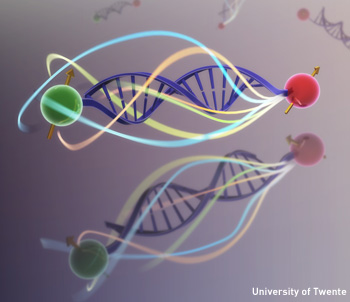 Artist's conception of energy donor and acceptor molecules separated by a precise length of DNA.
Artist's conception of energy donor and acceptor molecules separated by a precise length of DNA.
A specialized type of energy transfer between pairs of molecules happens in photosynthesis and other nanoscale processes. A team of European scientists has determined that the photonic environment surrounding the energy-transferring molecules controls the efficiency of the process (Phys. Rev. Lett. 109, 203601).
This type of “dance” between molecules is called the Förster resonance energy transfer (FRET), and is a near-field non-radiative shift of absorbed energy from a donor molecule to an acceptor molecule. Researchers use FRET to measure distances in the nanometer range and may play a role in future quantum computing systems, according to lead author Christian Blum, an assistant professor in the nanobiophysics group at the University of Twente in the Netherlands.
However, scientists have been debating whether the local environment controls the rate and efficiency of the FRET process. A predictable way of tuning FRET efficiency would allow researchers to enhance or suppress the process in nanoscale systems.
Blum and his colleagues attached two different types of fluorescent dye molecules to opposite ends of 15-base-pair strands of DNA. These strands kept the dye molecules spaced apart by 6.8 nm. The researchers floated these tiny tethered pairs in a thin alcohol layer just 270 nm above a silver mirror and compared the spectra from these samples to reference pairs in a system without a mirror (technically, an infinite distance from a mirror).
According to Blum, the rate at which FRET happens doesn’t change with the manipulation of the environment, but the efficiency of the process, from zero to nearly 100 percent, can be controlled accurately by the outside perturbation of changing the distance from the molecules to the mirror.
The results of the experiment will help improve nanometer-scale distance measurements and probes of molecular interactions. Next, Blum wants to study whether the “Förster radius,” or the distance at which 50 percent of the energy put into the donor molecule is transferred to the acceptor, can be changed.
Besides the University of Twente, Blum’s collaborators came from the FOM-Institute AMOLF (one of the Dutch national research laboratories) and the Technical University of Denmark.
